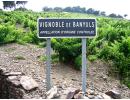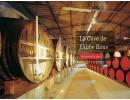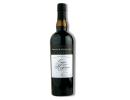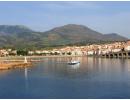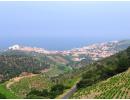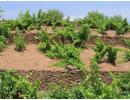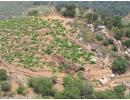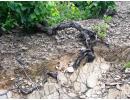Castell des Hospices
Castell des Hospices - Banyuls Grand Cru
A "rancio" style of Vin Doux Naturel (VDN) only produced if the quality of the vintage allows it. Made with 70 years old Grenache Noir producing a low yield of 20 hl/ha. The hand-picked grapes are destemmed and the grains are put into closed oak vats for the fermentations. After about 3 days of fermentations a natural alcohol level of 8% - 9% is reached. The must is now fortified with grape spirit (96% pure) which cannot exceed 10% of the must’s volume, the procedure is called “mutage sur grain”. After 3 weeks of macerations, the must is pressed and the wine is transfered to 225 litres oak barrels for ageing that will last 30 months with the barrels topped up. Following the barrel ageing the wine will be bottled and cellared for a further 6 years before release. The finished wine will have a residual sugar averaging 110g/l and an alcohol content of 17% Vol.
PVins notes: The result is a tawny coloured wine with very expressive flavours and aromas of dried sweet fruits such as raisin, dates and figs with hints of cigar box and nuts, a little Porty in style. The sweetness, alcohol and acidity are all well-balanced, the spirit is very well integrated, the length is very very long. An open bottle may be kept for up to 2 months, preferably in a cool environment. The cellaring potential is a few decades. It may be drank as an aperitif, with foie gras and of course a dark chocolate dessert. Recommended temperature for service is 14°c - 16°c.
Also produced by the Cave de l'Abbé Rous is Cornet & Cie Banyuls.
Castell des Hospices is bottled by the Cave de l’Abbé Rous since 1997, the cellar used to belong to the Municipal Hospice. The estate was selected by the Cave de L’abbé Rous with some other growers in the Collioure and Banyuls appellations. They were selected for their high quality vineyards, enabling them to produce high quality Banyuls, Banyuls Grand Cru and "cuvée spéciale". The cellar was named as an homage to the village priest Abbé Rous as h was the first person in 1871 to age and sell bottled Banyuls wines. His motivation behind the project was to finance the construction of a church as the newly appointed priest of Banyuls sur Mer.
The Banyuls wines produced by Cave de L’abbé Rous are considered to be amongst the best of the appellation. They can be found on the wine lists of numerous Michelin Star restaurants throughout France including up market delicatessen and cellars.
The vineyards of Castell des Hospices overlook the village of Banyuls sur Mer. Its old Grenache Noir vines averaging 70 years of age are some of the oldest in the appellation. They are planted in poor and eroded unfertile Cambrian schist soil facing east and south-east.
The winemaking process in producing fortified red Banyuls starts with the hand-picking of the Grenache grapes that have reached a high maturity with a sugar concentration equivalent to 252 grams of sugar per litre. At the cellar the grapes are destemmed and the grains put into closed oak vats for the fermentations to take place. After 3 to 4 days of fermentations a natural alcohol level of 8%-9% is reached. The must is now fortified with grape spirit (96% pure) which cannot exceed 10% of the must’s volume, the procedure is called “mutage sur grain”. This will stop the fermentation to keep some residual sugar as a Vin Doux Naturel (VDN). The must and spirit are left to macerate for 3 weeks. After the macerations the must will be pressed and the wine transfered to 225 litres french oak barrels for ageing. As a "Grand Cru" the wine will be aged for 30 months as per the appellation's regulation. The Castell des Hospices is aged as a "rancio" style of Banyuls, after ageing for 30 months in topped up barrels the wine is bottled and aged a further 6 years in the cellar before release. The wine will average a residual sugar of 110g/l with an alcohol content of 17% Vol.
Links: AOP Banyuls Grand Cru - Roussillon map
BANYULS GRAND CRU
The Banyuls appellation created in 1936 is well-known for its fortified wines. Located in the Roussillon region it faces the Mediterranean Sea near the Spanish border. The appellation spreads over the communes of Banyuls sur Mer, Collioure, Port-Vendres and Cerbère. The majority of Banyuls wines produced are red. In 1962, a new classification was created for the Banyuls Grand Cru appellation. As per the appellation's regulations, a Banyuls Grand Cru must be aged at least 30 months in oak, it must have a minimum of 75% Grenache Noir in the blend and the maximum yield is 30 hectoliters per hectare. These wines are mainly produced in excellent vintages.
History
Fortified wines have been made in the area since the 13th century by using the method of adding grape spirit (96% pure alcohol) on to the grape must to stop the fermentations, the technique is known as "mutage". This process of “Vin Doux Naturel” is attributed to Arnaud de Villeneuve a doctor in medicine at the University of Montpellier in the late 13th century.
Vineyard
The 927 hectares of vineyards are planted on terraces along steep slopes at the foothills of the Pyrenees. Here the vines are planted on Cambrian schist, a poor and arid soil. The grapes reach great maturity exposed to hot summers and the local strong dry northern wind called "Tramontane".
The predominant grape planted is Grenache Noir which must be at least 50% of the blend combined with Grenache Blanc, Grenache Gris, Macabeu and also in small quantity (not exceeding 10%) Carignan, Cinsault and Syrah. The small amount of white Banyuls produced are predominantly based on Grenache Blanc and Gris, but some Macabeu, Muscat and Malvoisie can also be used.
Since 2011, early bottled Banyuls are called “Rimage” which are fruit driven, but most common Banyuls are aged as “Rancio” in an oxidative environment for the wine to maderise either in the cellar or outside in the sun using large demi-muid oak barrels or large glass bottles called "bonbonne". The French tend to call the wines "Vin Cuit" meaning "cooked wine" for those produced under the sun. The flavours are complex of sweet ripe fruits such as plums, figs and dates. The Banyuls have a similarity with Port but with less sweetness and alcohol. The volume of grape spirit added to the must for the fortification cannot be higher than 10% and the wine's alcohol content is around 15% to 17%. The style of wines produced may be dry, semi-sweet and sweet. When young some will show an elegant tannic structure while the "Rancio" style will be similar to Port.
Climate
The climate is typically Mediterranean with hot summers and mild winters, the strong dry northern wind called "Tramontane" also influences the local climatic conditions.



